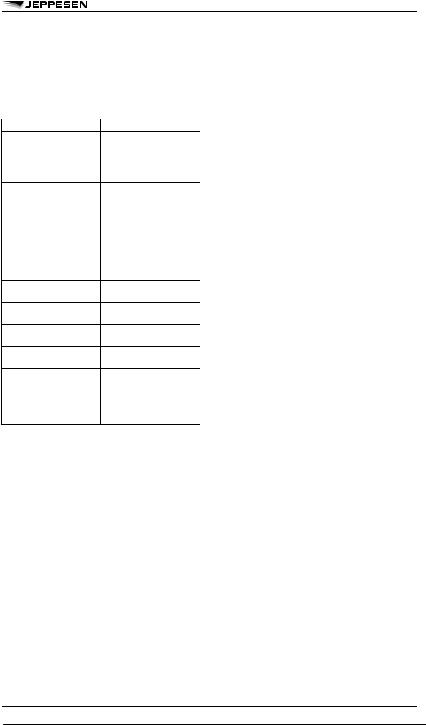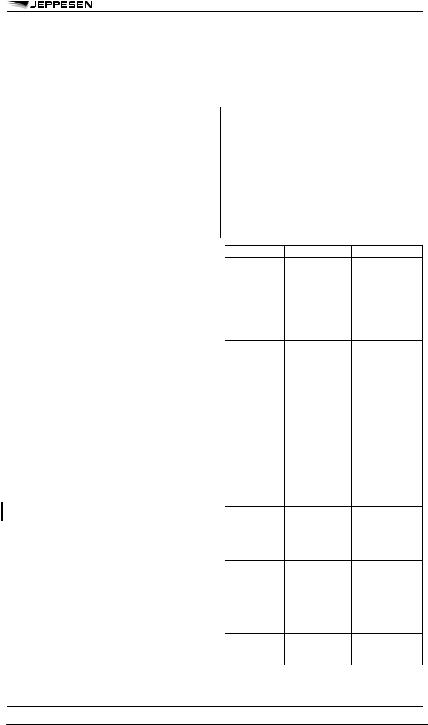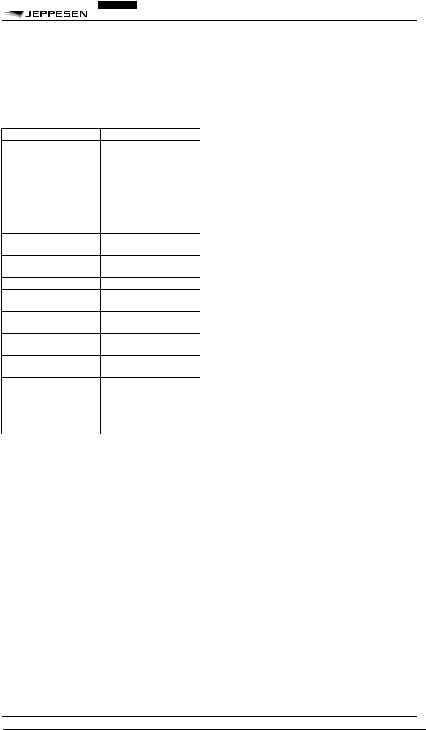
AIR TRAFFIC CONTROL
.pdf
5 NOV 10 AIR TRAFFIC CONTROL |
GERMANY-1 |
GERMANY - RULES AND PROCEDURES
GENERAL
In general, the air traffic rules and procedures in force and the organization of the air traffic services are in conformity with ICAO Standards, Recommended Practices and Procedures.
Units of measurement used in connection with all air traffic services in Germany:
Jeppesen charted minimums are not below State minimums.
OCA(H) Calculation Criteria for Large Aircraft (LACFT)
The following aircraft standard dimensions are taken as basis for the calculation of OCA(H) for ILS approaches.
Wing span 65 - 80m, vertical distance between the flight paths of the wheels and the glide path antenna not more than 8m.
NOTE: The official term used for LACFT is DL
NOISE ABATEMENT PROCEDURES
Take-off/Departure
Departing aircraft are requested to apply the following procedures:
a.Aircraft licensed in accordance with ICAO Annex 16, Chapter 2
1.Take-off to 1500ft GND
–take-off power
–take-off flaps
–climb at V2 + 10KT (or as limited by angle of attack)
2.At 1500ft GND
–reduce power to not less than climb power
WGS-84 IMPLEMENTATION STATUS
WGS-84 compliant.
FLIGHT PROCEDURES
HOLDING
Holding procedures comply with Jeppesen ATC-Chapter “Flight Procedures (DOC 8168) - Holding Procedures”, Table IV-1-1, Holding Speeds.
PROCEDURE LIMITATIONS AND OPTIONS
Instrument approach procedures for civil airports comply with the new PANS-OPS, Document 8168, Volume II.
Instrument approach procedures for military aerodromes are based on the United States Standards for Terminal Procedures (TERPS).
AIRPORT OPERATING MINIMUMS
General
Germany publishes OCA(H)s for civil airports and DA/MDA, ceiling and visibility for military aerodromes. In-flight visibility are published for landing at CologneBonn, Hamburg (Finkenwerder) and Westerland/Sylt aerodromes.
3.1500ft GND to 3000ft GND
–climb at V2 + 10KT
4.At 3000ft GND
–acceleration during climb and retraction of flaps
–normal transition to enroute climb.
b.Aircraft licensed in accordance with ICAO Annex 16, Chapter 3, as well as B 737-200 as far as the noise levels for take-off pursuant to ICAO Annex 16, Chapter 3 have probably been reached by supplementary equipment
1.Take-off to 1500ft GND
–take-off power
–take-off flaps
–climb at V2 + 10KT (or as limited by angle of attack)
2.At 1500ft GND
–reduce power to not less than climb power
–acceleration during climb and retraction of flaps
–normal transition to enroute climb.
Approach
Arriving aircraft leave the initial approach fix at 210 KT IAS ± 10KT, maintain until 12NM from touchdown (unless higher IAS is required for control purposes). Reduce speed to 160 KT IAS ± 10KT using an intermediate flap setting with landing gear retracted. Intercept glide path at not lower than 3000ft above touchdown elevation.
© JEPPESEN, 1990, 2010. ALL RIGHTS RESERVED.

GERMANY-2 |
AIR TRAFFIC CONTROL 5 NOV 10 |
|
GERMANY - RULES AND PROCEDURES |
Lower landing gear, set flaps for landing and establish final approach speed shortly before or over Outer Marker.
SPEED RESTRICTIONS
Flights of civil aircraft with supersonic speed (exceeding Mach 1.0) are prohibited.
ATS AIRSPACE CLASSIFICATIONS
Germany has adopted the ICAO ATS airspace classification as listed in ATC chapter “ICAO ATS Airspace Classifications - Annex 11”.
Airspace classes “A” and “B”, however, are not allocated within German airspace.
ATC clearance is required for IFR flights operating in class “F” airspace.
IFR flights are not permitted within class “G” airspace.
The competent ATC unit may grant exceptions in individual cases to the speed limitation below FL100:
–for VFR flights in class “C” and “D” airspace and at night in class “E” airspace,
–for IFR flights in class “D” airspace.
Enroute GAT VFR flights shall not be operated above FL195 in class “C” airspace.
For differences from ICAO VMC specifications see relevant paragraph below.
SPECIAL REQUIREMENTS AND REGULATIONS
START-UP PROCEDURES AT GERMAN AIRPORTS
To maintain an orderly flow of aircraft movements, it is necessary that pilots of aircraft departing in accordance with an IFR flight plan request a start-up clearance. Aircraft departing in accordance with a flight plan including a change from VFR to IFR, are recommended to request a start-up clearance.
The start-up clearance shall not be requested before it has been ascertained that the aircraft can start the engines within 5 minutes after the clearance has been issued.
When the expected delay is less than 20 minutes, pilots will be cleared to start engines immediately. When the expected delay is 20 minutes or more, pilots will be informed as to the time when the engines may be started.
AVOIDANCE OF WAKE TURBULENCE
a.Increased separation minima will be applied in an effort to minimize the hazard caused by wake turbulence.
b.When radar separation is applied, the minimum distances will be:
–“Heavy” behind “Heavy”- 4NM
–“Medium” behind “Heavy”- 5NM
–“Light” behind “Heavy”- 6NM
–“Light” behind “Medium”- 5NM
c.When Air Traffic Control is exercised without radar, time separation on approach will be:
–“Medium” behind “Heavy”- 2 min
–“Light” behind “Heavy”- 3 min
–“Light” behind “Medium”- 3 min
d.Pilots having the preceding aircraft in sight and being able to attend a safe distance themselves may inform ATC that increased separation minima are not required.
e.Pilots of uncontrolled flights are advised to observe the aforementioned separation minima whenever they are behind an aircraft of higher wake turbulence category either at the same altitude or less than 1000ft below.
f.When taxiing behind an aircraft of higher wake turbulence category a minimum distance of 200m should be kept whenever possible.
WAKE TURBULENCE CATEGORY
B757
Aircraft type B-757 is grouped into the weight category “HEAVY” because of its wake turbulence characteristics. Separation from and for these aircraft will be provided according to the wake turbulence separation minima for aircraft with 136000kg take-off mass or more. Pilots of B-757 aircraft who, following an aircraft of the weight category “HEAVY”, require the application separation minima in accordance with the criteria for aircraft of the weight category “MEDIUM”, shall report this to the competent ATS unit in due time and of their own accord.
Pilots of B-757 aircraft are not expected to add the word “HEAVY” to their call sign when establishing radio contact with ATC units or when changing frequencies.
A380
Wake turbulence category for airbus A380 at present exclusively: J (super).
TRANSMISSION OF EXPECTED APPROACH TIMES
If IFR flights are expected to hold for more than 20 minutes over the navigation aid serving as clearance limit, ATC will generally transmit the EAT to the pilot.
If the holding time is 20 minutes or less, the EAT will be transmitted only when it is considered necessary by ATC.
If ATC clearance for continuation of the flight beyond the navigation aid serving as clearance limit has not been issued, the pilot shall enter the holding pattern, maintain the level last assigned and confirmed, and await further ATC clearances.
POSITION REPORTING PROCEDURES
a.When making a position report, the pilot shall transmit the following data in the sequence listed:
–radio call sign of aircraft,
–position,
–time of crossing.
b.After changing the radio telephony frequency, the following data shall be transmitted:
–radio call sign of aircraft,
© JEPPESEN, 1990, 2010. ALL RIGHTS RESERVED.

30 JUL 10 AIR TRAFFIC CONTROL |
GERMANY-3 |
GERMANY - RULES AND PROCEDURES |
|
–level and, if climbing or descending, cleared level. (This indication is not required when changing from approach control to aerodrome control.)
For approaches to airports with parallel runway system, the designation of the runway being approached shall be indicated in addition to the radio call sign of the aircraft.
FLIGHT PLANNING
IFPS/CFMU OPERATIONS
The Integrated Initial Flight Plan Processing System element of the EUROCONTROL Central Flow Management Unit (CFMU) is the sole source for the distribution of the IFR General Air Traffic (GAT) FPL and associated messages to ATS units within the IFPS. The only required addresses are those of the two IFPS Units (IFPU) at Haren (Brussels) and Bretigny (Paris).
Flight Plan Message Addressing
AFTN: EUCHZMFP and EUCBZMFP
SITA: BRUEP7X and PAREP7X
NOTE: Aircraft Operators who do not have the facilities to file direct to IFPS may continue to use the services of the ATS Reporting Office serving the aerodrome of departure. For complete details on the IFPS and CFMU procedures, refer to the Eurocontrol CFMU manuals or to the Jeppesen European Air Traffic Flow and Capacity Management (EATFCM) User Guide.
Filing of flight plans via the Internet
Flight plans and flight plan associated messages within the context of services covered by ATC charges only, may be filed via the Internet. These messages are filed with AIS-C via the Internet-Appli- cation:
AIS-C
Internet: www.dfs-ais.de
VISUAL DEPARTURES FOR IFR FLIGHTS
Visual departures are IFR flights which - while retaining visual contact to the ground - deviate completely or partially from the published IFR departure routes.
IFR flights may be cleared for a visual departure by ATC if the special conditions listed below apply:
a.The pilot applies for this procedure or agrees to it,
b.the ceiling does not lie below the minimum radar vectoring altitude or the pilot announces immediately before departure that the meteorological conditions permit a visual departure and he is sufficiently confident that he can carry out this procedure,
c.the procedure is applied during day time only,
d.the procedure is limited regarding a certain altitude,
e.the departure does not enter Class “G” Airspace.
Examples
“When airborne turn left direct KNG maintain visual reference to the terrain until passing 2000ft.”
“When airborne fly heading 190 maintain visual reference to the terrain until passing 1600ft.”
© JEPPESEN, 1990, 2010. ALL RIGHTS RESERVED.

GERMANY-4 |
AIR TRAFFIC CONTROL 30 JUL 10 |
|
GERMANY - RULES AND PROCEDURES |
OPERATIONAL CRITERIA AND PILOT QUALIFICATION TO USE GPS STAND ALONE NON-PRECISION APPROACH PROCEDURES
Operational Criteria
Prior to using the published GPS standalone non-pre- cision approach procedures, the following operational criteria in particular must be fulfilled:
a.Commercial operators wanting to perform GPS standalone non-precision approaches must enter the regulations (including crew coordination concept) into the operating handbook and present it to the Supervisory Authority for approval;
b.the use of satellite navigation systems in aircraft operated commercially or non-commercially must generally be conducted in keeping with the instructions of the manufacturer in the approved flight manual and the operating instructions;
c.the State of operator/registry (as applicable) has authorized the use of multi-sensor equipment using GPS as one sensor or GPS Class A1 (standalone equipment) for the purpose;
d.the navigation database contains current information on the non-precision approach to be flown (actual AIRAC cycle);
e.the navigation data stored in the navigation data base must correspond to the published non-precision approach to be flown (actual AIRAC cycle);
f.the navigation database waypoints showing the non-precision approach cannot be changed by the flight crew;
g.the integrity monitoring function (RAIM or an equivalent procedure) is available;
h.RAIM prediction or an equivalent prediction procedure offered by the air navigation service provider will be used which guarantees that the monitoring capability (RAIM or equivalent procedure) is available at the destination airport at the Expected time of Arrival;
i.where a destination alternate is required, landings at the alternate airport must be possible according to a non-Global Navigation Satellite System (GNSS/GPS) approach procedure;
j. where |
a take-off |
and/or |
enroute |
alter- |
nate |
is required, |
landings |
according |
to a |
non-GNSS/GPS based approach procedure must be possible at the respective alternate airport.
GENERAL REQUIREMENTS FOR PILOT QUALIFICATION
Pilots wishing to carry out GPS stand alone non-pre- cision approaches must have familiarized themselves sufficiently with the basic principles, special features and restrictions of GPS, as well as the handling of the GPS equipment on board the aircraft.
Pilot qualification for the use of the GPS procedures and GPS receivers must be proved. Such proof may be provided, for example, in the form of certificates issued by the equipment manufacturers, IFR flight training centers as well as by flight instructors, authorized trainers and technical experts in possession of an IFR rating, respectively. Proof may be entered in the pilot’s logbook.
AIRPORT COORDINATION
a.For all take-offs and landings of scheduled, charter and cargo flights (including ferry, technical and training flights) at the coordinated airports EDDF, EDDM, EDDL, EDDS, EDDT, EDDB, airport slots for allocation shall be applied for exclusively from the Airport Coordinator during his office hours. At the airports to which a flight plan has been transmitted: EDDW, EDDC, EDDE, EDDH, EDDV, EDDK, EDDP, EDDG, EDDN and EDDR, the arrival and departure times shall be reported to the Airport Coordinator:
The Airport Coordinator of the Federal
Republic of Germany
Address: |
Terminal 2 (Fac II), Bereich E |
|
HBK Nr. 37 |
|
Frankfurt/Main |
|
D-60549 |
Tel: |
+49 (0) 69 690 29501 |
|
+49 (0) 69 690 52341 |
|
+49 (0) 69 690 45601 |
|
+49 (0) 69 690 73892 |
|
+49 (0) 69 690 52351 |
|
+49 (0) 69 690 73361 |
|
+49 (0) 69 690 73362 |
|
+49 (0) 69 690 52331 |
Fax: |
+49 (0) 69 690 50811 |
|
+49 (0) 69 690 59603 |
E-Mail: |
FRAZTXH@FHKD.ORG |
Internet: |
www.fhkd.org |
SITA: |
FRAZTXH |
AFTN: |
EDDFYHYX |
Public Hours: Monday to Friday 0700 - 1600 (0600 - 1500 summer time)
b.For all IFR take-offs and landings of General Aviation (except ambulance flights and helicopter flights):
Airport coordinator of the Federal
Republic of Germany
Address: |
Terminal 2 (FAC II), Bereich E |
|
HBK Nr. 37 |
|
Frankfurt/Main |
|
D-60549 |
Tel: |
+49 (0) 69 690 73360 |
Fax: |
+49 (0) 69 690 50811 |
E-Mail: |
FRAZRXH@FHKD.ORG |
Internet: |
www.fhkd.org |
© JEPPESEN, 1990, 2010. ALL RIGHTS RESERVED.

7 JAN 11 |
AIR TRAFFIC CONTROL |
GERMANY-5 |
GERMANY - RULES AND PROCEDURES
SITA: FRAZRXH
AFTN: EDDFYHYX
Public Hours: Monday to Friday 0700 - 1600 (0600 - 1500 summer time)
Airport slots for IFR General Aviation flights at completely coordinated airports may be applied for from AIS-C outside the office hours of the Airport Coordinator:
Aeronautical Information Service Centre (AIS-C)
Tel: |
+49 |
(0) |
1803 337247 |
|
+49 (0) |
69 78072500 |
|
Fax: |
+49 (0) |
1803 329247 |
|
|
+49 (0) |
69 78072505 |
|
AFTN: |
EDDZZPAJ |
||
EXECUTION OF IFR ARRIVALS BASED ON AREA NAVIGATION IN THE RADAR VECTOR AREA OF AIRPORTS
Applicability
At Berlin (Schönefeld), Berlin (Tegel), Bremen, Dresden, Dusseldorf, Erfurt, Frankfurt-Hahn, Frankfurt/Main, Friedrichshafen, Hamburg, Hannover, Cologne-Bonn, Leipzig-Altenburg, Leipzig-Halle, Lubeck (Blankensee), Munich, Nurnberg, Stuttgart airports, flight procedures, designated as Transition to Final Approach, have been implemented which comply with the radar vectoring practised at the respective airport. Clearances for these flight procedures may be granted by the ATC unit on the following conditions only.
Conditions for granting clearances for Transition to Final Approach Procedures
Clearances for Transition to Final Approach procedures may be granted by the ATC unit if the aircraft is equipped as follows:
–at least 1 x FMS or
–at least 1 x GPS/GNSS (TSO C129) certified for approaches.
Navigation systems (without navigation data bases) requiring a manual data (coordinate) input are exempt from utilization of these procedures.
If, after receiving clearance for a Transition to Final Approach procedure, the pilot reports that he is not equipped for this procedure or not ready to implement it, the ATC unit shall grant an alternative clearance.
NOTE: By utilizing these procedures, a reduction in radio communication as well as optimized flight guidance in the approach section based on realistic flight path data are possible. The turn to final approach is as a rule performed by radar vector to expedite traffic handling and for separation reasons, resp.
Transmission of the clearance
Clearance is transmitted by applying the following phraseology:
a.CLEARED (designator) TRANSITION
Permission to fly the lateral part of a Transition to Final Approach routing, including assigned speeds. Altitudes will be assigned separately.
b.CLEARED (designator) TRANSITION AND PROFILE
Permission to fly a Transition to Final Approach routing including assigned speeds and altitudes.
c.PROCEED DIRECT WAYPOINT (designator) and/or CLEARED VIA WAYPOINTS (designator) AND (designator) AND (designator)
Permission to fly from the present position direct to one waypoint and/or via a combination of waypoints, including the continuation of the flight on the lateral part of a Transition to Final Approach routing adjoining the last waypoint, including assigned speeds. Altitudes will be assigned separately
NOTE: The designation of waypoints is based on the last two letters of the four letter ICAO location indicator and additionally three digits. In radio communications, the respective waypoint number only shall be used if applicable. e.g.: PROCEED DIRECT WAYPOINT (designator).
IFR TRAINING APPROACHES AND TESTFLIGHTS
Due to Flow Management Reasons testflights and successive IFR Training Approaches at EDDL, EDDK, EDDG, EDLN, EDLV, EDLW, EDLP and ETNG are subject to prior coordination with:
Langen ACC supervisor:
Tel: |
+49 (0) 6103 707 6600 |
Individual regulations for the appropriate aerodrome still remain.
ACAS II/TCAS II REQUIREMENTS
Civil fixed-wing turbine-engined aircraft having a maximum take-off mass exceeding 5700kg, or a maximum approved passenger seating configuration of more than 19, are required to be equipped with ACAS II (at least TCAS II with software change 7).
Aeroplanes operated for the purpose of commercial air transportation, whose ACAS II is inoperative, may be despatched only in accordance with the contents of their TCAS II MEL.
Aircraft whose airborne collision avoidance system (ACAS/TCAS) is unserviceable may still be operated with the unserviceable collision avoidance system for three calender days after the unserviceability status was ascertained.
To preclude any unnecessary transponder interrogations and possible interference with surface movement radar systems ACAS/TCAS shall not be activated before entering the runway-in-use.
Following the landing or when vacating the runway-in- use ACAS/TCAS shall be switched off, but the Mode S transponder shall not be switched off until the aircraft has reached the final parking position and the engines have been shut down.
DATALINK DEPARTURE CLEARANCE
Deutsche Flugsicherungs GmbH will start providing start-up approval and enroute clearances via datalink (in the following referred to as DCL). DCL will be gradually implemented and offered by further DFS units.
© JEPPESEN, 1990, 2011. ALL RIGHTS RESERVED.

GERMANY-6 |
AIR TRAFFIC CONTROL 7 JAN 11 |
|
GERMANY - RULES AND PROCEDURES |
Message Types
RCD — Request for departure clearance downlink message of the pilot requesting start-up approval and the enroute clearance.
CLD — Departure clearance uplink message - issuance of start-up approval and enroute clearance by the air traffic controller.
CDA — Departure clearance readback message - confirmation of start-up approval and enroute clearance by the pilot.
FSM — Flight system uplink message - automatic acknowledgement of receipt of RCD/CDA by air traffic control system, or the interruption of the DCL dialogue by the controller.
Time Parameters
The maximum duration of the DCL process is limited by time parameters.
ti — Earliest point in time at which the request for start-up approval and enroute clearance (RCD) may be transmitted.
tt — The point in time at which the DCL dialogue is finished or at which the pilot can assume that the process cannot be finished and sufficient time remains to obtain the start-up approval and enroute clearance via radiotelephony.
t0 — The period of time between the transmission of an RCD and receipt of an FSM by the pilot.
t1 — The period of time between the transmission of a CLD and receipt of a CDA by the air traffic control system.
t2 — The period of time between the transmission of a CDA and receipt of an FSM by the pilot.
The defined time parameters will be published for each airport in the AD section of the AIP Germany.
Procedure
The participating pilots shall maintain listening watch on the frequency published for the start-up approval.
In the event of any doubts or system-related difficulties, voice procedures shall be resumed. A clearance issued by voice procedures supersedes a transmitted datalink clearance. If the de-icing of the aircraft is required prior to departure, the start-up approval and enroute clearance will only be issued by voice procedures.
Prior to departure, both the pilot and the competent air traffic controller shall verify that the departure route assigned via DCL logically refers to the runway used and to the route indicated in the current flight plan. In the event of any deviations or doubts, voice procedures shall be resumed.
a.The pilot shall request start-up approval and enroute clearance by means of an RCD not earlier at point ti.
NOTE: The data to be transmitted (e.g.: airline code, aircraft type) shall correspond to the data contained in the current flight plan.
b.As soon as the air traffic control system has received the RCD, t he FSM will be transmitted automatically. If the RCD is rejected by means of negative FSM, the pilot shall revert to voice procedures.
c.A CLD is used to issue a start-up approval and enroute clearance and to transmit the designator of the current ATIS broadcast, the CTOT available at the Tower. Next frequency and, if necessary, information in the free-text field. If a CTOT is not available, the acronym MDI (Minimum Departure Interval) will be transmitted.
d.The pilot shall confirm a CLD by means of a CDA. If the pilot does not transmit the CDA
within the timeframe t1 , the air traffic control system will automatically issue a negative FSM together with the instruction to revert to voice procedures.
NOTE: In order to ensure integrity between clearance (CLD) and readback (CDA), the CDA may not differ from the CLD. The air traffic control system will not accept and process different
CDAs.
e.As soon as a CDA has been processed successfully, the air traffic control system will transmit a positive FSM. Only when the FSM has been received, the process is completely finished.
f.If it is not possible to issue the start-up approval together with the enroute clearance, the free-text field will contain a time at which the start-up approval is regarded as issued, or the pilot receives an FSM with the instruction to revert to voice procedures.
CONTROLLER PILOT DATA LINK COMMUNICATION SERVICES (CPDLC)
Germany implemented ATS Data Link Services in all parts of the Hannover UIR airspace under the responsibility of Maastricht UAC.
Aircraft operators wishing to conduct CPDLC in this airspace shall first register with Maastricht UAC. Registration shall be made a minimum of 4 weeks prior to the first intended CPDLC flight of an operator in the airspace:
Volker Stuhlsatz Eurocontrol MAS-UAC
Operational & Airspace Systems
Address: |
AC Maastricht Airport |
|
|
NL-6191 |
|
Tel: |
+31 |
43 366 1510 |
Fax: |
+31 |
43 366 1502 |
E-Mail: |
Volker.Stuhlsatz@Eurocontrol.int |
|
DIFFERENCES FROM ICAO STANDARDS AND PROCEDURES
ICAO REFERENCE
ANNEX 2
3.2.2.3 An aircraft shall give way to another aircraft that is obviously impeded in its manoeuvrability.
© JEPPESEN, 1990, 2011. ALL RIGHTS RESERVED.

7 JAN 11 |
AIR TRAFFIC CONTROL |
GERMANY-7 |
GERMANY - RULES AND PROCEDURES
3.2.3.1 All aircraft operated during day and night shall display the anti-collision light.
Exceptions may be granted by the competent authority.
3.2.5a On aerodromes aircraft taxiing under own power have the right-of-way over other vehicles and pedestrians.
3.3.1.2 In addition to ICAO provisions a flight plan shall be filed in the following cases:
–VFR flights during night as far as they exceed the vicinity of an aerodrome,
–aerobatic flights in controlled airspace and over aerodromes with ATC unit,
–cloud flights of gliders,
3.6.5.1 In addition to the provisions for controlled flights, a continuous listening watch on the appropriate radio frequency of the competent ATC unit shall be maintained and, if required, two-way radio communication shall be established with this unit by pilots on VFR flights:
a.to controlled aerodromes,
b.within controlled airspace during night.
Exceptions may be granted by the competent authority.
3.6.5.2 An aircraft on a VFR flight may only enter a control zone if the pilot has previously received a corresponding ATC clearance or if, due to flight operational reasons, a landing at an aerodrome within the control zone is unavoidable.
If, on a VFR flight, radio communication fails prior to entering Airspace Class C below FL100 or Airspace Class D (non-control zone), the pilot shall continue the flight in accordance with the ATC clearance received and acknowledged or, if this is not possible, shall leave this area on the shortest route, observing the minima.
If radio communication failure occurs within Airspace Class C at or below FL100, the pilot shall leave this airspace by the shortest route, observing the minima.
4. All control zones are airspace class D. The VMC minima of class D apply to control zones, with the exception that distance from cloud shall be maintained in accordance with the rule: “Clear of cloud”. In addition, the ground visibility shall be 5km and the ceiling 1500ft.
In airspace class E, the flight visibility shall be 8km below FL100.
In airspace class F, the distance from cloud shall be 1.5km horizontally and 1000ft vertically.
Following VMC minima are required for VFR flights in airspace class G: Permanently in sight of the surface, flight visibility of 1.5km, clear of cloud. Rotorcraft, airships and balloons: Permanently in sight of the surface, flight visibility of 800m, clear of cloud.
Appendix 1, 4.1.1
Light signals for aerodrome traffic consisting of series of green flashes have in addition to “Return for Landing” the following meaning “Continue Approach”.
© JEPPESEN, 1990, 2011. ALL RIGHTS RESERVED.

21 DEC 07 AIR TRAFFIC CONTROL |
GREECE-1 |
GREECE - RULES AND PROCEDURES
GENERAL
In general, the air traffic rules and procedures in force and the organization of the air traffic services are in conformity with ICAO Standards, Recommended Practices and Procedures.
Units of measurement used in connection with all air traffic services in Greece:
WGS-84 IMPLEMENTATION STATUS
Starting with year 2001, WGS-84 reference datum has been largely introduced at many airports and in the en-route airspace structure, but full implementation is not yet completed.
FLIGHT PROCEDURES
HOLDING
Holding procedures comply with ATC Chapter “Flight Procedures (DOC 8168) Part IV. Holding Procedures”, table “Holding Speeds ICAO Doc 8168”.
PROCEDURE LIMITATIONS AND OPTIONS
Instrument approach procedures on civil aerodromes comply with the new PANS-OPS, Document 8168, Volume II. Instrument approach procedures on military aerodromes comply with the new PANS-OPS, Document 8168, Volume II or are based on United States Standards for Terminal Procedures (TERPS).
The PANS-OPS or TERPS label is shown in the lower left corner of the chart. On older charts a MILITARY label might be shown and the smaller circling areas are described in the circling minimums box.
 Circling Approach Area (TERPS)
Circling Approach Area (TERPS)
Radii (r) defining size of areas, vary with the approach category.
A minimum obstacle clearance of 300’ is provided within the circling approach area.
AIRPORT OPERATING MINIMUMS
Greece publishes OCA(H)s, or OCLs and visibilities for landing.
Jeppesen charted minimums are not below State minimums.
SPECIAL REQUIREMENTS AND REGULATIONS
OPERATION OUTSIDE CONTROLLED OR ADVISORY AIRSPACE
Aircraft and helicopters shall not be flown outside the lateral limits of controlled or advisory airspace unless permission has been obtained from ATC.
RADAR ADVISORY SERVICE
Service is available on frequency 129.80MHz callsign “TUGRIT SERVICE”. If contact on the above frequency is not possible aircraft in emergency may call the emergency frequency of 121.5MHZ using the same callsign (TUGRIT SERVICE).
CONTROLLED FIRING AREA
In addition to Danger Area, Restricted Area and Prohibited Area the term CONTROLLED FIRING AREA has been introduced which is defined as an airspace of defined dimensions within which firing of projectiles and missiles takes place and is coordinated in such a manner that air traffic operating through that area is not endangered. The letter ‘C’ has been assigned to identify Controlled Firing Area.
FLIGHT PLANNING
Flight plans for all flights entering/exiting the Athinai FIR/UIR shall include FIR/UIR entry and exit points in item 15 of the FPL.
© JEPPESEN, 1991, 2007. ALL RIGHTS RESERVED.

GREECE-2 |
AIR TRAFFIC CONTROL 21 DEC 07 |
|
GREECE - RULES AND PROCEDURES |
IFPS/CFMU OPERATIONS
The Integrated Initial Flight Plan Processing System element of the EUROCONTROL Central Flow Management Unit (CFMU) is the sole source for the distribution of the IFR General Air Traffic (GAT) FPL and associated messages to ATS units within the IFPS. The only required addresses are those of the two IFPS Units (IFPU) at Haren (Brussels) and Bretigny (Paris).
FLIGHT PLAN MESSAGE ADDRESSING
AFTN: EBBDZMFP and LFPYZMFP SITA: BRUEP7X and PAREP7X
Repetitive Flight Plans (RPL)
Aircraft Operators are reminded that RPL data is to be addressed to the:
CFMU
RPL Section
Address: Rue de la Fusee 96 Brussels
B-1130
in parallel with their normal submissions, as required, and to National Authorities.
For complete details on the CFMU and IFPS procedures, refer to the Eurocontrol CFMU manuals or to the Jeppesen European Air Traffic Flow and Capacity Management (EATFCM) User Guide.
FLOW MANAGEMENT POSITIONS
Operational ATFCM enquiries should normally be addressed to following local FMPs:
Athinai FMP covering Athinai ACC Hellenic Civil Aviation Authority Athinai FMP
Athinai Area Control Center
Address: |
P.O. 70360 |
|
|
GLYFADA |
|
|
GR 16610 |
|
Tel: |
+30 |
2109972654 |
|
+30 |
2109972693 |
Fax: |
+30 |
2109972590 |
SITA: |
ATHECYA |
|
AFTN: |
LGGGZDZX |
|
Makedonia FMP covering Makedonia ACC Hellenic Civil Aviation Authority Makedonia FMP
Athinai Area Control Center
Address: |
P.O. 70360 |
|
|
GLYFADA |
|
|
GR 16610 |
|
Tel: |
+30 |
2109972654 |
|
+30 |
2109972693 |
Fax: |
+30 |
2109972590 |
SITA: |
ATHMKYA |
|
AFTN: |
LGMDZDZX |
|
General ATFCM enquiries should be addressed to the FMP Manager:
ATH/MAK FMPs
Hellenic Civil Aviation Authority
Air Navigation Department
Athinai ACC |
|
|
Address: |
POB 70360 |
|
|
GLYFADA |
|
|
GR 16610 |
|
Tel: |
+30 |
2109972656 |
Fax: |
+30 |
2109647329 |
E-Mail: |
yepfmp@otenet.gr |
|
SPECIFIC REQUIREMENTS
Air carriers violating the allocated slots at the regional fully co-ordinated airports by +/- 30 minutes are subject to a monetary penalty equal to 8000 Euros. Where the deviation is justified by certain codes as they are described in the IATA’s Airport Handling Manual (23rd Edition) no penalty will be imposed. The following codes are exempted: 18, 41 to 48, 51, 52, 71 to 77, 81 to 89, 97 and 98.
A monetary penalty accounting 12000 Euros will be imposed, when an air carrier operates without an allocated slot or the carrier’s aircraft remains on the ground for more than 2hrs in a regional fully co-ordinated airport without prior permission by the appropriate authorities.
A SLOT performance committee is established for the evaluation of violations. No penalty will be imposed without any prior decision of the committee.
 ACAS II/TCAS II REQUIREMENTS
ACAS II/TCAS II REQUIREMENTS
All civil fixed-wing turbine-engined aircraft having a maximum take-off mass exceeding 5700kg, or a maximum approved passenger seating configuration of more than 19 will be required to be equipped with ACAS II.
DIFFERENCES FROM ICAO STANDARDS AND PROCEDURES
ICAO REFERENCE
ANNEX 2
3.9 Outside controlled airspace helicopters may operate clear of clouds with a flight visibility of 800m (0.5 mile) provided they are flying at a speed that will give adequate opportunity to observe other traffic or obstruction in time to avoid collision.
© JEPPESEN, 1991, 2007. ALL RIGHTS RESERVED.

Eff |
AIR TRAFFIC CONTROL |
IRELAND-1 |
4 FEB 11 |
IRELAND - RULES AND PROCEDURES
GENERAL
In general, the air traffic rules and procedures in force and the organization of the air traffic services are in conformity with ICAO Standards, Recommended Practices and Procedures.
Units of measurement used in connection with all air traffic services in Ireland:
WGS-84 IMPLEMENTATION STATUS
WGS-84 compliant.
FLIGHT PROCEDURES
HOLDING
Holding procedures comply with Jeppesen ATC-Chapter “Flight Procedures (DOC 8168) - Holding Procedures”, Table IV-1-1, Holding Speeds.
PROCEDURE LIMITATIONS AND OPTIONS
Instrument approach procedures for civil airports comply with the new PANS-OPS, Document 8168, Volume II.
Instrument approach procedures for military aerodromes are based on the United States Standards for Terminal Procedures (TERPS).
AIRPORT OPERATING MINIMUMS
Ireland publishes OCA(H)s for civil airports and DA/MDA, ceiling and visibilities for military aerodromes.
Jeppesen charted minimums are not below State minimums.
ATS AIRSPACE CLASSIFICATIONS
Ireland has adopted the ICAO ATS airspace classification as listed in ATC-Chapter “ICAO ATS Airspace Classifications - Annex 11”.
Airspace Classification “A” comprises Shannon Oceanic Transition Area (SOTA) and Northern Oceanic Transition Area (NOTA) at and above FL55 to FL660.
Airspace Classification “C” comprises
–Shannon UTA FL245 - FL660
–Shannon CTA at and below FL245
–Dublin CTA at and below FL245
–CTR’s Cork, Dublin and Shannon
–CTR’s Connaught, Donegal, Galway, Kerry, Sligo and Waterford during promulgated hours of activation
Airspace Class “G” comprises all airspace within Shannon FIR, excluding airspace classified “C” as described above.
SPECIAL REQUIREMENTS AND REGULATIONS
ACAS II/TCAS II REQUIREMENTS
Civil fixed wing turbine-engined aircraft exceeding 5700kg, or a maximum approved passenger seating configuration of more than 19, are required to be equipped with, and operate ACAS II.
FLIGHT PLANNING
IFPS/CFMU OPERATIONS
The Integrated Initial Flight Plan Processing System element of the EUROCONTROL Central Flow Management Unit (CFMU) is the sole source for the distribution of the IFR General Air Traffic (GAT) FPL and associated messages to ATS units within the IFPS. The only required addresses are those of the two IFPS Units (IFPU) at Haren (Brussels) and Bretigny (Paris).
FLIGHT PLAN MESSAGE ADDRESSING
AFTN: EUCHZMFP and EUCBZMFP SITA: BRUEP7X and PAREP7X
For complete details on the IFPS and CFMU procedures, refer to the Eurocontrol CFMU manuals or to the Jeppesen European Air Traffic Flow and Capacity Management (EATFCM) User Guide.
FREE ROUTE AIRSPACE
Free Route Airspace concept is implemented within the Shannon UTA, Northern Oceanic Transition Area (NOTA) and the Shannon Oceanic Transition Area (SOTA).
Airspace users will be permitted to flight plan direct routeing “DCT” between any of the published 5 letters waypoints or radio navigation beacons within the area. Routes between these points will be indicated by means of the “DCT” instruction however there will be a 600NM limitation on the physical length of these segments.
© JEPPESEN, 1989, 2011. ALL RIGHTS RESERVED.
